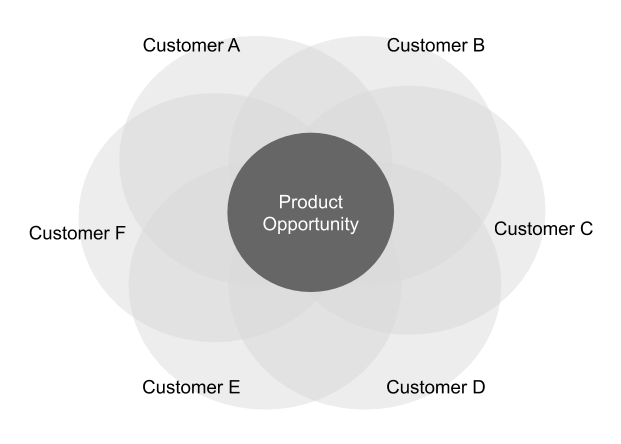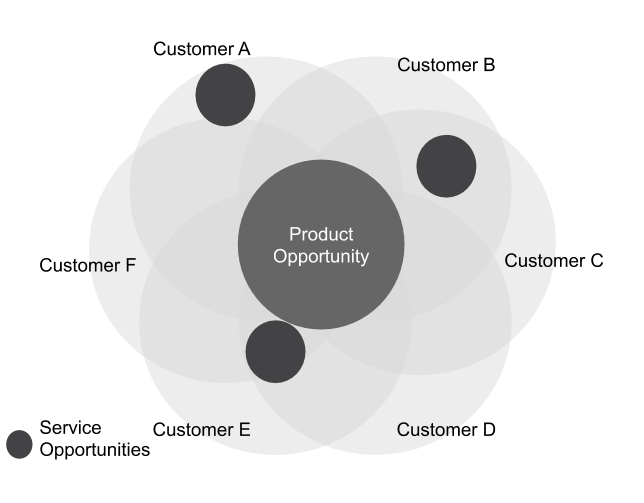The Value of Services in a Product Business
“Product” and “service” mean different things in different contexts. My frame of reference is business to business (B2B) software, where the distinction between products and services can be blurry. Software that is packaged and billed via a license or subscription (SaaS) model is often referred to as a “product.” Software development that is delivered and billed via an input (time & materials) or outcome (milestone) based model, is often referred to as “professional services” or “services”.
The unit economics of products and services are very different. Products are relatively expensive to produce, but cheap to reproduce. Services are inexpensive to deliver, but that same cost is incurred each time they are delivered. Relative to products, services have low fixed costs. They may not require any up-front investment. However, services have high marginal costs. Costs, mostly payroll, increase in proportion to revenue. Relative to services, products have high fixed costs. They may require significant up-front investment before even a single unit can be sold. However, products have low marginal costs. Marginal product revenue is almost entirely profit. This difference in unit costs is driving the productization of services.
Customers buy and use solutions, not products or services. Every product or service addresses a job to be done. In most cases, customers don’t care how the job gets done. How the job gets done only matters insofar as it impacts the experience or outcome. The wizard of Oz approach, common in chatbots and transcription apps, illustrates this. The user thinks they are interacting with some sophisticated technology, when in fact it’s just a human behind a thin curtain of software.
Imagine a Venn diagram in which a single customer’s needs are represented by a circle, their “need set.” When many customer need sets overlap, that’s a potential product opportunity:
 Good products address a widely held customer need as directly as possible. The best products zoom in to focus on the most narrowly defined need that is shared by many customers. While few customers might use all features of a product, most customers should use each feature. This principle is so widely held that failure to do so has a name - feature creep. If a great product addresses a narrowly defined need, then by definition, it does not address adjacent needs. While a product solves a need for every customer, it almost certainly doesn’t solve every need for any customer. That’s where services can come in:
Good products address a widely held customer need as directly as possible. The best products zoom in to focus on the most narrowly defined need that is shared by many customers. While few customers might use all features of a product, most customers should use each feature. This principle is so widely held that failure to do so has a name - feature creep. If a great product addresses a narrowly defined need, then by definition, it does not address adjacent needs. While a product solves a need for every customer, it almost certainly doesn’t solve every need for any customer. That’s where services can come in:
 Services can be complementary to the core product(s) such that the total solution addresses a greater portion of a customer’s need set. Enterprise customers want a solution that solves as much of their “need set” as possible. Sales professionals know this all too well. Enterprise sales processes often devolve into a feature checklist exercise, as Patrick McKenzie describes in Selling To The Fortune 500, Government, And Other Lovecraftian Horrors. Moreover, many enterprises don’t want to string together a bunch of independent products (though this is changing). Systems integration is expensive and error prone. Managing relationships with technology providers is time consuming and distracting. It’s much better to have the proverbial one throat to choke - a single technology provider to hold accountable. All else equal, a more comprehensive solution is an easier sell than a less comprehensive one.
Services can be complementary to the core product(s) such that the total solution addresses a greater portion of a customer’s need set. Enterprise customers want a solution that solves as much of their “need set” as possible. Sales professionals know this all too well. Enterprise sales processes often devolve into a feature checklist exercise, as Patrick McKenzie describes in Selling To The Fortune 500, Government, And Other Lovecraftian Horrors. Moreover, many enterprises don’t want to string together a bunch of independent products (though this is changing). Systems integration is expensive and error prone. Managing relationships with technology providers is time consuming and distracting. It’s much better to have the proverbial one throat to choke - a single technology provider to hold accountable. All else equal, a more comprehensive solution is an easier sell than a less comprehensive one.
Even after the initial sale, unaddressed adjacent needs pose problems for software companies. An unsolved need might be the difference between the customer using the product or not using it. Similarly, an unsolved need is an opportunity for a competitor to establish a beachhead with a customer by addressing that need alone. Worse still, an opportunity to unseat your product entirely with something more comprehensive. All else equal, a more comprehensive solution makes for a better customer experience. Better customer experiences lead to greater retention.
If offering services enables customers to close that otherwise might not have closed, and customers to be retained that otherwise would not have been retained, it follows that offering services maximizes product revenue. Even if services are offered at cost (without profit), they increase product revenue, which again, is almost entirely profit. Dave Kellogg sums this up pithily in The Role of Professional Services in a SaaS Business:
Professional services exists to maximize ARR while not losing money
This is a great mission statement for a professional services team, but it misses the most important strategic value of services in a software business. Service delivery is an excellent venue for new product research and experimentation. Service delivery demands a much deeper relationship with a customer than product delivery alone. Through this exposure, a company can learn more about its customers. Through services, a company might even assume the role of its customer. Paul Graham explains how he and his team did this at his startup, Viaweb, in Do Things that Don’t Scale:
When we approached merchants asking if they wanted to use our software to make online stores, some said no, but they’d let us make one for them. Since we would do anything to get users, we did. We felt pretty lame at the time. Instead of organizing big strategic e-commerce partnerships, we were trying to sell luggage and pens and men’s shirts. But in retrospect it was exactly the right thing to do, because it taught us how it would feel to merchants to use our software. Sometimes the feedback loop was near instantaneous: in the middle of building some merchant’s site I’d find I needed a feature we didn’t have, so I’d spend a couple hours implementing it and then resume building the site.
Of course, there is a tradeoff. At some margin, offering services can be a distraction from, or a crutch for, the core product(s). Not just in terms of a revenue perspective, but also a customer experience perspective. Companies must be willing to stop offering services that don’t either drive product revenue or have potential for productization. Graham raises this risk in How to Fund a Startup:
So you have to be very disciplined if you take the consulting route. You have to work actively to prevent your company growing into a “weed tree,” dependent on this source of easy but low-margin money.
Customers buy solutions to their needs - some, but not all of which are shared with other customers. While products are the core offerings of successful technology companies, the combination of both products and services yields better, more comprehensive solutions for customers. The combination maximizes product revenue and therefore profitability. Importantly, service delivery enables accelerated product refinement through deeper customer relationships and tighter feedback loops.